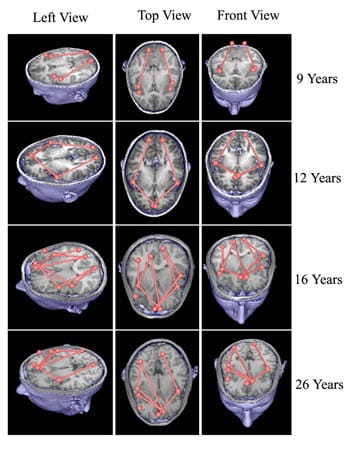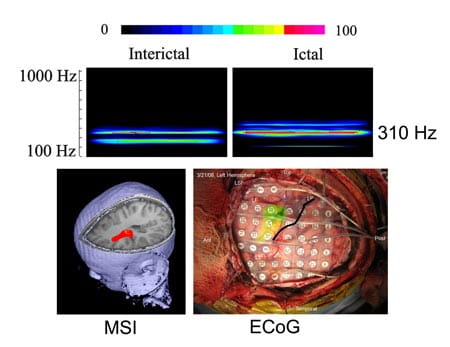High-Frequency Neuromagnetic Signals
High-Frequency Neuromagnetic Signals in the Developing Brain
This project uses magnetoencephalography (MEG) to characterize the normal neuromagnetic profile in children of intrinsic neuromagnetic activities and sensorimotor, auditory, visual and language elicited magnetic fields in 0-2,000 Hz. Since MEG can detect neuromagnetic signals with high spatial and temporal resolution, many brain properties can be studied. Currently, we are focusing on three areas:
- The patterns of synchronization and de-synchronization of resting state activity and elicited cortical activation
- The volumetric extent of these active sensorimotor, auditory, visual and language cortices
- The coherency pattern of neuromagnetic activation in the developing brain (see figure 2)
This approach may lead to a new way to study the brain functions in normal children and in children with various brain disorders.
Funded by a trustee grant.
Pathologic High-Frequency Neuromagnetic Signals in Childhood Epilepsy
This project has three aims:
- Quantify the differences and similarities of HFBS recorded noninvasively with MEG to those recorded invasively with intracranial EEG
- Determine how outcome of epilepsy surgery correlates with resection of the regions generating epileptic HFBS recorded noninvasively with MEG
- Determine spatial and temporal differences in primary and secondary ictogenic zones noninvasively with causality analysis of MEG data in 0-3,000 Hz
Visual identification of spikes (14-70 Hz) in invasive EEG recordings is the widely used method for estimating ictogenic zones. This work is innovative because it examines the relationship between HFBS and ictogenic zones noninvasively (using MEG). This is a novel use of MEG, and we will use new data analysis techniques to accomplish this work.
If successful, MEG localization of HFBS could replace risky intracranial recordings and improve the outcome of epilepsy surgery. After causality analysis of MEG HFBS, a single ictogenic focus may be identified in patients thought to have multiple epileptic areas based on current methodologies. As a result, additional patients may have successful surgery.
Funded by a trustee grant, NIH / NINDS R01-NS072341 (pending).





